In this article, we will take a look at some of the common vegetable cutting techniques used in Japanese cooking.
Chef Goku’s Top Picks! Do you need an authentic Japanese Knife first? Check out my popular article: 🔪 The Best Japanese Knives – A Buying Guide
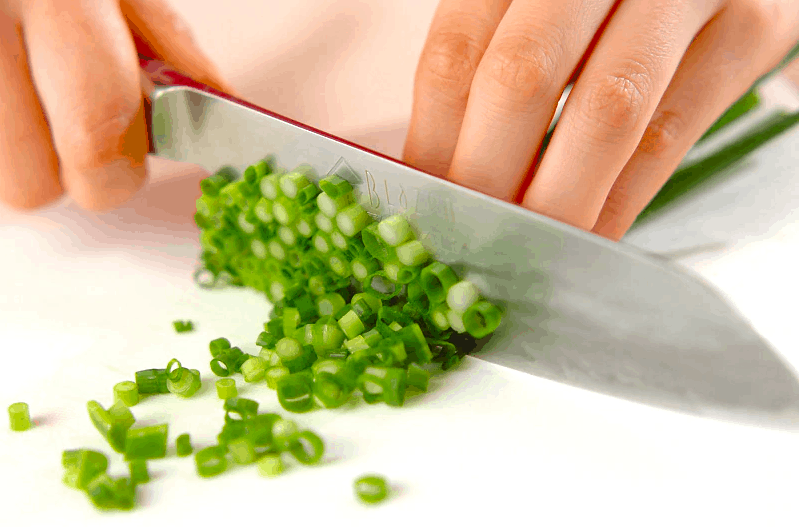
You may be familiar with some various terms like dice, slice, chop, and mince. But, what exactly is the difference between all of these?
Not sure? Don’t worry, neither am I.
These vague, seemingly random terms and phrases used to describe cutting techniques are just another intimidating factor for beginners to overcome. Unfortunately, in Japanese cooking, there are approximately 100 times more cutting techniques and names.
On the bright side, the techniques are all very precisely/uniquely named, which actually makes them a tiny bit easier to remember and distinguish from each other.
Don’t bother trying to memorize everything. Just use this list for reference. You will slowly learn the most common techniques as you start cooking more.
Always combine these techniques with good, basic knife skills to keep your hands/fingers safe. Once you master these, you will hopefully be able to make your dishes look as good as they taste!
Skip ahead? Basic techniques / Intermediate techniques / Advanced techniques / Conclusion
Basic Japanese vegetable cutting techniques
Here are the most common, basic techniques and names. With these you can make all basic Japanese recipes.
Wa-giri (輪切り) – Round slice
Refers to making round/circular slices from cylindrical items like carrots and cucumbers. Usually a bit thicker than the above mentioned usui-giri.

Often used with: carrots, cucumbers, daikon, tomato, eggplant
Hangetsu-giri (半月切り)- Half-moon cuts
Cuts vegetables into half-circles. Very common technique for a variety of dishes and presentation. Usually used with long cylndrical vegetables like cucumber and carrots.
How to:

- Cut the vegetable in half length wise, so that there is one flat side.
- Place the flat side down, then proceed to cut into multiple slices. Try to keep every slice the same width, so that they cook at the same speed.
Often used with: cucumber, radish (daikon), tomato, eggplants, carrots, potato, lotus root
Icho-giri (いちょう切り) – Ginkgo leaf cuts
Cuts vegetable in quarter circle shapes. Most often used for soups and stews. The quarter-round shape is supposed to resemble a ginkgo leaf (ichou いちょう in Japanese).
How to:

- Cut the vegetable in half length wise so that there are 2 long pieces.
- Cut each half piece lengthwise again (now there are 4 pieces).
- Keep the two quarters together, then cut vertically to make ginkgo leaf slices
Often used with: Carrots, radish (daikon)
Ran-giri (乱切り) – Random shaped cuts
Cut vegetables into irregular shapes, but of the same size. Very useful technique as it increases surface area of each piece which allows it to cook faster and absorb more flavor. Often used for stews, curries, and soups.
How to:

- Start from one end of the vegetable. Cut it diagonally (approximately 45 degree angle). I find it better to rotate the vegetable as opposed to turning your knife.
- Roll vegetable 90 degrees towards yourself, then make the same diagonal cut
- Repeat until the entire vegetable is cut
Often used with: Carrots, cucumbers, daikon, eggplant
Hyoushigi-kiri 拍子木切り – Wood “clapper” cuts
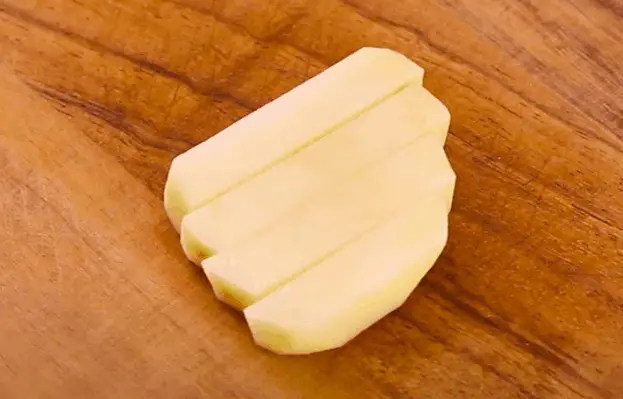
Cuts vegetables into strips that resemble small rectangular wooden poles, or sticks. Each “pole” is usually 4-5cm long and 1cm thick.
The name (hyoushigi 拍子木) means wooden “clapper” – a traditional Japanese instrument. It is basically two wooden sticks that are banged together to make a unique sound. If want to know what they are, check out this video here.
How to:
- Cut ingredient into round slices (i.e. wagiri)
- Cut each round slice into evenly sized strips
Often used with: carrots, daikon, potato
Kakugiri 角切り – Cube cuts / dice
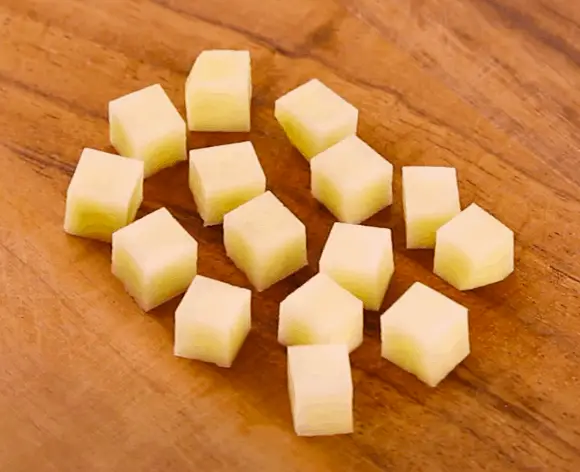
Refers to cutting ingredients into evenly sized cubes. Very useful for soups and stews. After cutting ingredients using the above hyoushigi-kiri (wood clapper method), simply cut the strips into cubes.
How to:

- First, cut ingredient into thick round slices (i.e wa-giri)
- Cut each round slice into evenly sized strips
- Cut strips into cubes
Often used with: Carrots, potatoes, daikon
Sainome-kiri さいの目切り – Small cube / dice
Smaller version of the above mentioned kaku-giri. Refers to cutting ingredients into small cubes; usually about 1cm in size.
Arare-kiri あられ切り – Extra small cube / dice
An even smaller version of the above sainome-kiri and kaku-giri. Each cube is usually about 5mm in size.
Tanzaku-kiri 短冊切り – Thin Rectangular Strips
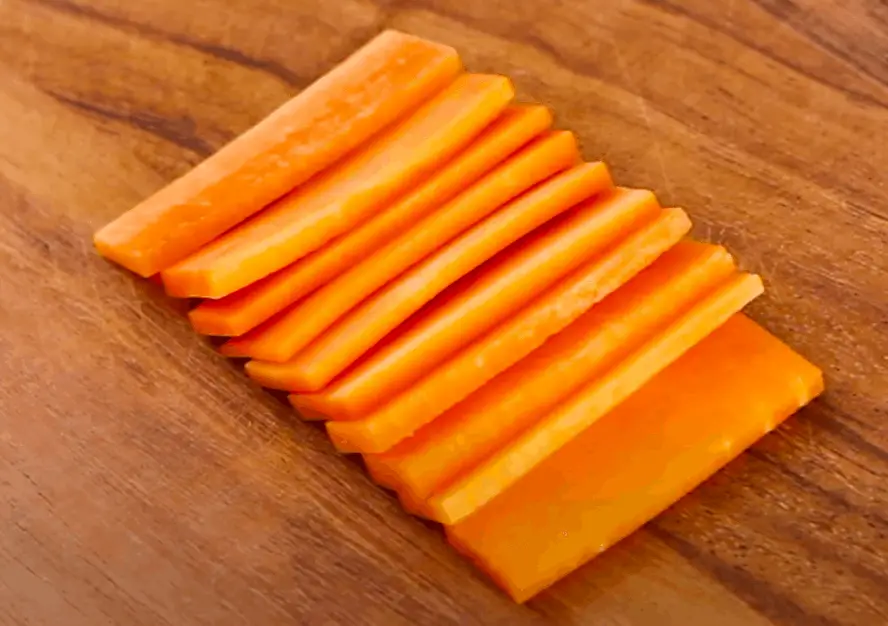
Cuts ingredients into thin rectangular strips. Each strip is usually around 4-5cm long, 1cm wide, and 2mm thick. Used for soups and stir fried dishes.
How to:
Often used with: Carrots, daikon
Hitokuchi-dai-ni-kiri ひと口大に切る / 一口大に切る- Bite sized cuts
Cuts ingredients into bite-sized pieces. Pieces are usually around 3cm or less per side. Used often for side dishes or anything that should be eaten in one bite 🙂

How to:
Often used with: cabbage, potatoes, green pepper (paprika)
Kushi-gata-giri くし型切り – Comb shaped / Wedge cuts
Refers to cutting a round/oval ingredient (e.g. onion) into wedges (or “combs”). The name (kushi-gata) means “comb shaped” in Japanese, as I guess these resembles a comb?
How to:

Often used with: Onion, tomato, pumpkin
Zaku-kiri ザク切り – Sukiyaki Vegetable Cuts
Refers to cutting leafy vegetables like cabbage into large pieces around 3-4 cm wide. Usually for use in hot pot/sukiyaki / shabu-shabu. “Zaku” means vegetables for sukiyaki.
How to:

Often used with: Cabbage, lettuce, other green leafy vegetables
Ko-guchi-giri 小口切り – Small edge cuts
Refers to cutting long narrow ingredients into small round slices. Most often used with green onion (ねぎの小口切り). Usually for garnishing or seasoning purposes. Try to keep every slice the same width.
How to:
- Tips: Take your time and use proper holding technique to avoid chopping your fingers 🙂
Often used with: green onion, cucumber
Butsu-giri ぶつ切り – Chunk cuts
Refers to cutting ingredients into large chunks, usually around 3-4cm in width. More often used to refer to cutting meats or fish, but sometimes also used for vegetables like onions and leeks.
How to:

Naname-giri 斜め切り – Diagonal cuts
Refers to cutting ingredient at an angle, usually around 45 degrees or more. Results in oval slices as opposed to circular slices (i.e. wa giri). Useful for cutting long narrow ingredients like cucumbers and green onion.
How to:
Tips: Rotate the ingredient (e.g. cucumber) instead of your knife.
Often used with: cucumber, green onion.
Usui-giri 薄い切り – Thin slice
More of a general term that refers to any basic thin slice. Remember to hold your ingredients and knife correctly to avoid cutting your fingers!

Often used with: cucumber, ginger, onion, eggplant, carrots, green onion
Intermediate cutting techniques
Intermediate cutting techniques add an extra layer or step on top of the above basic techniques. Generally require a tiny bit more skill and confidence in your knife wielding abilities, but with a little bit of practice are all quite doable for the normal person.
Hoso-giri 細切り – Matchsticks / Julienne
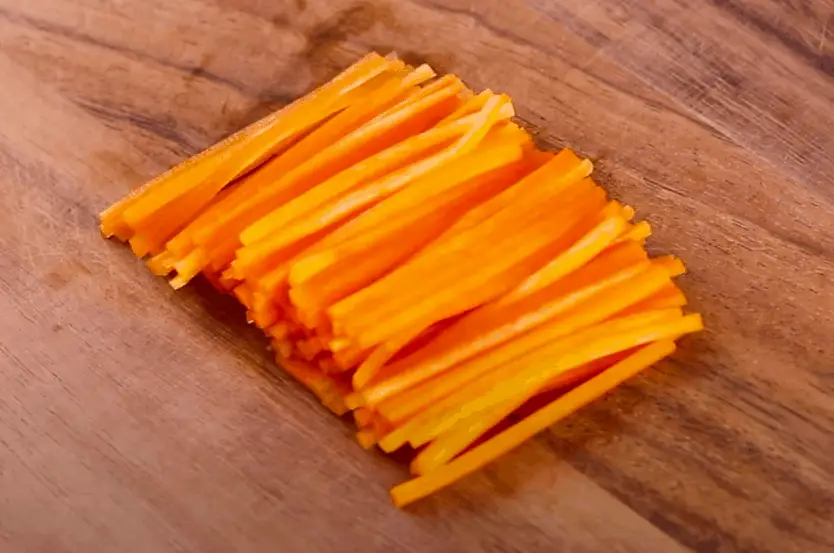
The Japanese equivalent of matchstick or “julienne” cuts. Cuts ingredients into fine strips. “Hoso” translates to fine. Often used for various stir fried dishes like yakisoba, etc.
How to:

2. Spread rectangular strips out, layered on top of each other
3. Cut rectangular strips into fine stips
Often used with: Carrots, cucumbers, daikon, ginger, bell pepper (paprika)
Sen-giri せん切り – Exra fine matchsticks/julienne
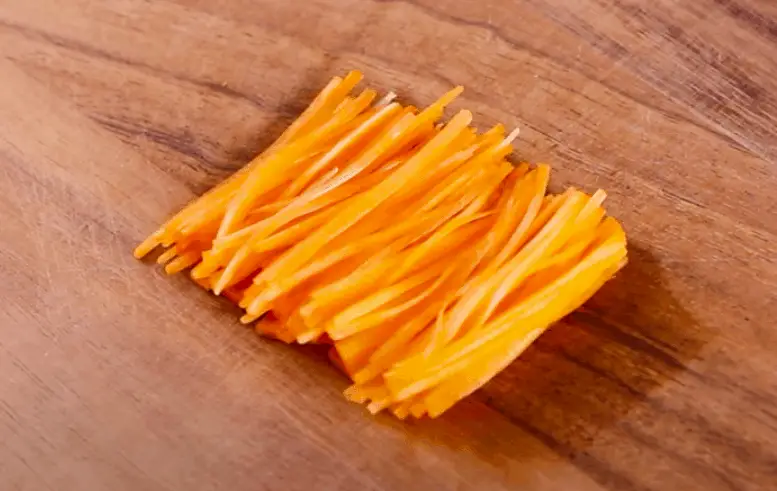
If this picture seems familiar, that’s because it is. Sen-giri is just an even thinner version of the above mentioned hoso-giri / matchsticks. ‘Sen‘ means thousand, so you can think of it as a thousand cuts. This technique is often used for shredding cabbage to be used for okonomiyaki, salads, and side dishes (i.e. sengiri-kyabetsu – 千切りキャベツ ) .
How to (Cabbage Sen-giri)

Mijin-giri みじん切り – Fine Mince

Refers to cutting ingredients into very small/fine pieces (i.e. mince). Mostly used for ingredients which are for flavoring rather than the main focus (e.g. garlic, ginger, onion, etc.).
How to (e.g. onion):

Often used with: ginger, garlic, onion, green onion
Sogi-giri そぎ切り – Shave cut
Refers to inserting at a slight angle, and slicing the ingredient using a pull cut. Generally used with thicker ingredients. Increasing the angle of your knife (i.e. making knife more parallel with cutting board) will increase the surface area of each slice, which helps it absorb more flavor in the cooking process.
This technique is also often used with meats and fish (e.g. sashimi).
How to (e.g. shiitake mushroom):
Often used with: shiitake mushroom, Chinese cabbage
Advanced Cutting Techniques
Most of the advanced vegetable cutting techniques are used by professionals and restaurants for decorative or other visual purposes. They require a lot of confidence, skill, and practice!
Shatoo-kiri シャトー切り – Chateau Cuts
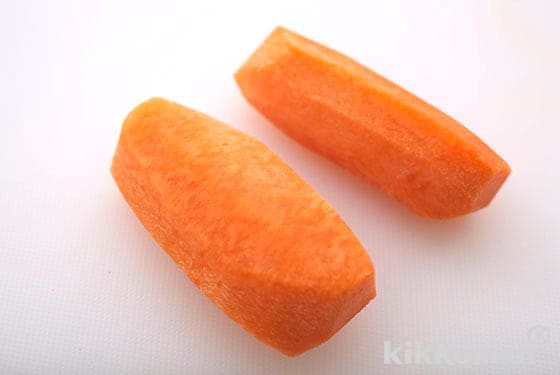
Refers to cutting ingredients into an ovalish football /rugby ball type shape. Usually around 5-6cm in length, and used for more Western inspired dishes like beef stew. The name is a bit odd, but I guess the pieces are supposed to resemble a classic French chateau/castle? Sometimes also referred to as Kokotto-kiri (ココット切り) for smaller versions. I have no idea what that is in reference to.
How to:
Shiraga-negi 白髪ねぎ – White haired green onion cuts
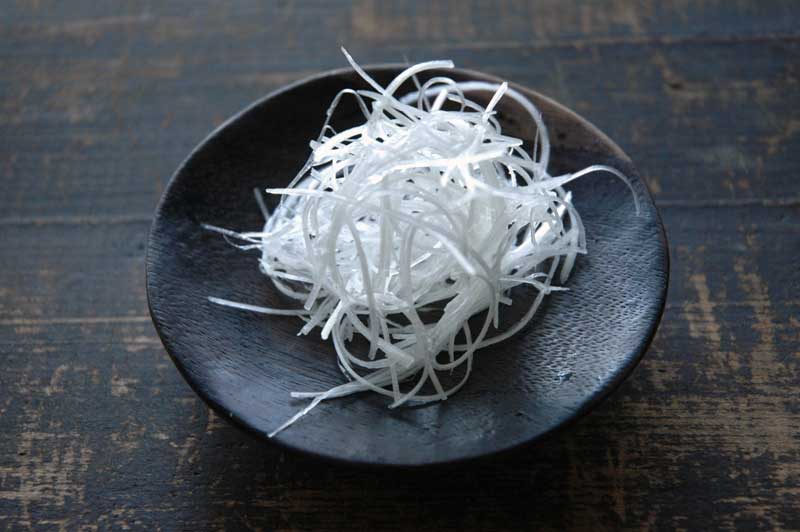
Refers to cutting the white part of a green onion (i.e. spring onion) into thin hair like strands. Usually used for decorative or garnishing purposes. After cutting, the green onion is soaked in cold water to make them crispier, and remove some of the spicy taste.
If you aren’t so skilled, there are actually tools specifically made for this cut.
How to:
Sasagaki ささがき – Bamboo Leaf Cuts
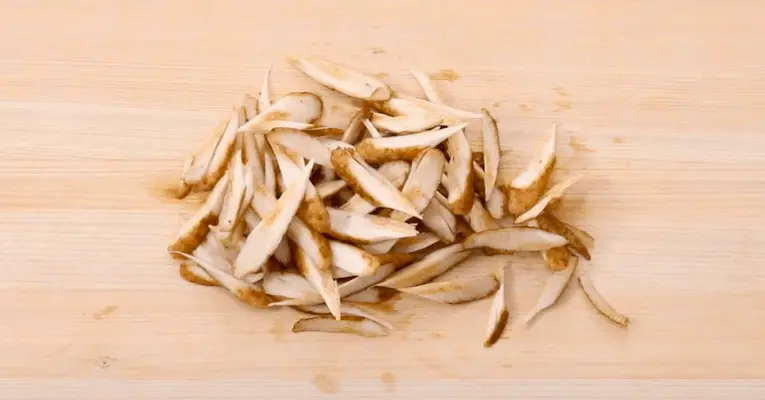
Refers to cutting long ingredients like burdock root into thin shreds/shavings. The shavings resemble bamboo leaves, hence the name.
How to:
Ropponmuki 六方むき – Hexogan Cut

Refers to cutting an ingredient into a hexagonal prism — i.e. a 6-sided shape.
Often used for fancy looking stews and other decorative dishes.
How to:
Often used with: daikon, taro, carrot
桂むき Katsura-muki – Rotary peel cut
Refers to transforming a cylinder shaped ingredient (e.g. daikon) into one long, thin peel. The peel is then usually further cut for decorative purposes (i.e. kazari-kiri 飾り切り).
Katsura-muki is one of the most difficult cutting techniques. It requires immense skill and practice to not break the peel part way, and to keep the thickness consistent all the way around. I sometimes like to refer to this as the toilet paper cut 🙂
“Katsura” is a type of tree found in Japan.
How to katsura-muki:
Kazari-kiri 飾り切り – Decorative Cutting
A general term that refers to any type of decorative cuts. The previously mentioned ropponmuki 六方むき is an example of a basic decorative cut.
There are some crazy skilled chefs out there that can turn a carrot into anything beyond your imagination. Check out some cool examples below:
“Simple” how to video:
Conclusion
There you have it — only 3901 different vegetable cutting techniques and names that you NEED to memorize in order to cook Japanese food.
Just kidding.
Use this list as a reference for when you need to remember how to make a certain cut, or if you want to get creative with some of your dishes. The basic cutting techniques will come naturally as you begin cooking more often. The intermediate techniques may take a bit more practice before you are confident with them. The advanced techniques give you something to aspire to as you gain more experience and knife skills.
How are your knife skills? Let me know in the comments below!
Resources:
https://www.kikkoman.co.jp/homecook/basic/vege_cut/index.html
https://park.ajinomoto.co.jp/recipe/basic/vege_cutting/
https://housefoods.jp/recipe/kihon/cut/cut_04.html
https://www.kurashiru.com/
Subscribe for free today! Receive cool recipes, my latest Japanese knife picks and learn about Japanese culture. Delivered every other week to your inbox.












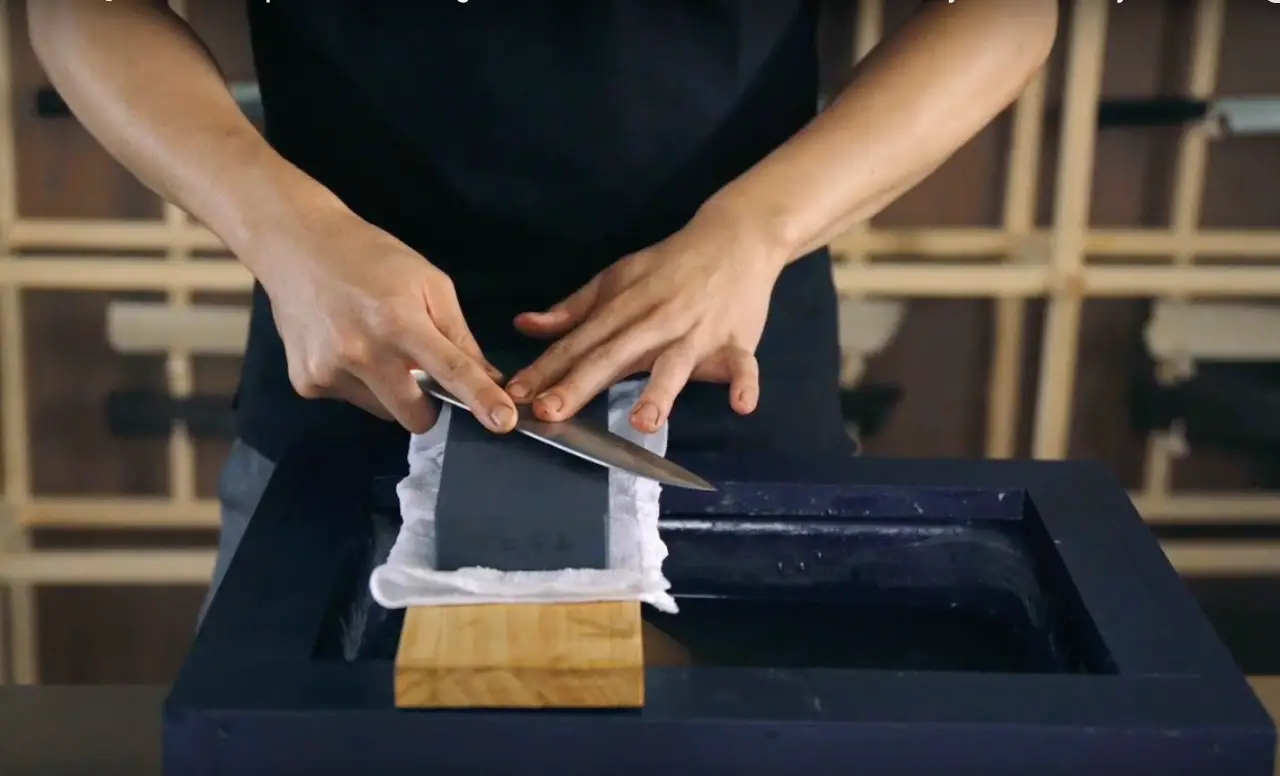
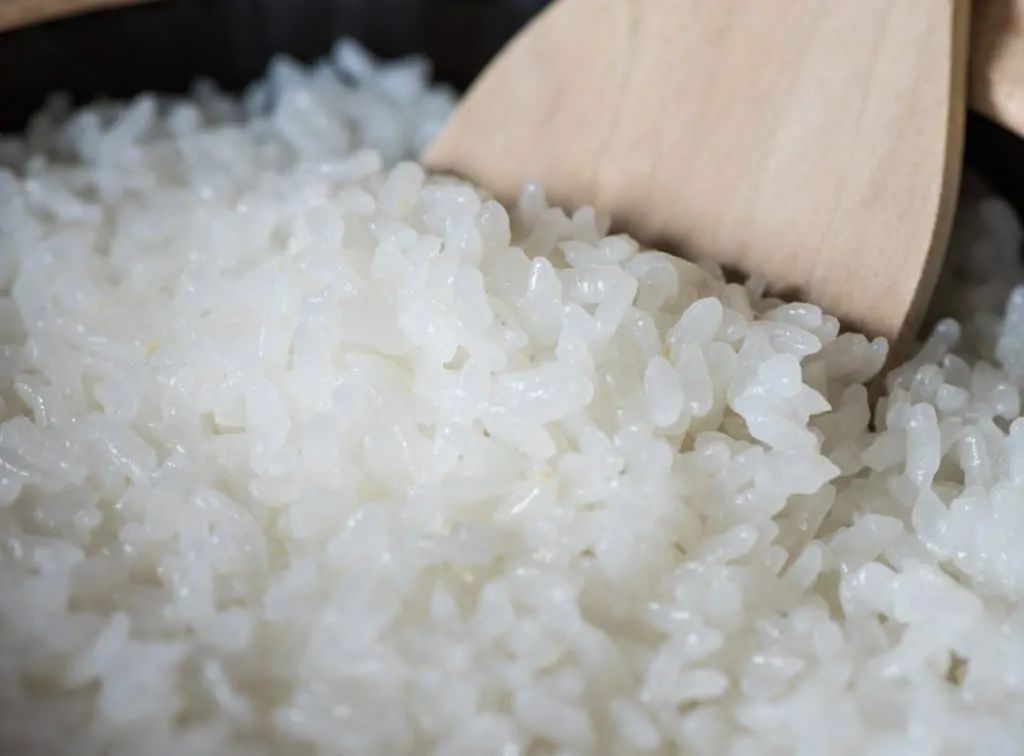
Thank you for this guide. I often wondered about the so-called “secret” Japanese cutting techniques, but now seeing what they actually are, I have to say they’re pretty standard, easy to achieve and not “secret” at all. They exist in other cultures as well.
Another case of people exaggerating any little thing about Japan to make themselves more interesting, I guess…
Thank you very much for sharing, I learned a lot from your article. Very cool. Thanks.